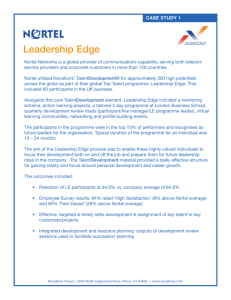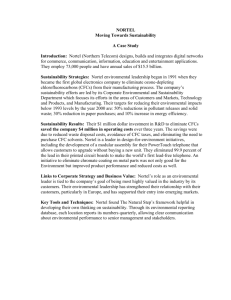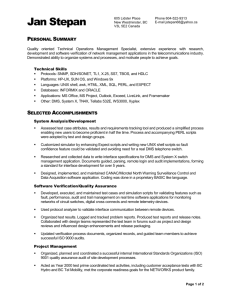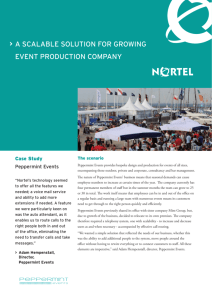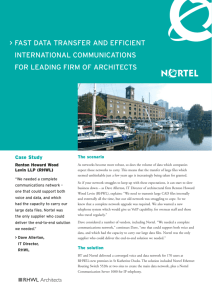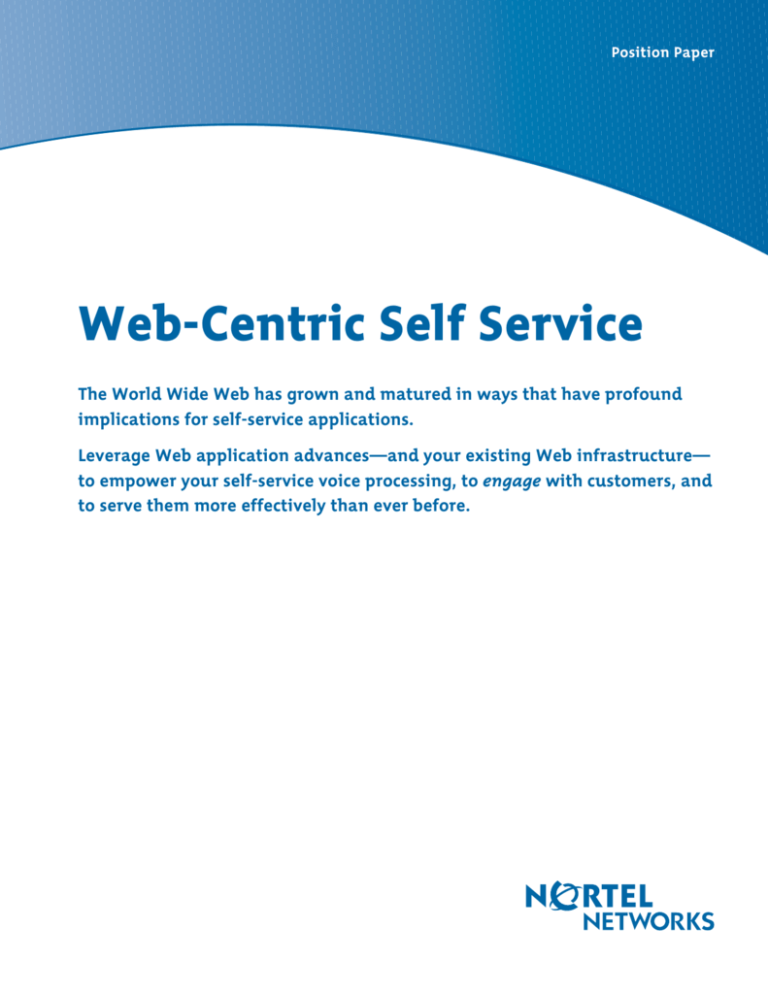
Position Paper
Web-Centric Self Service
The World Wide Web has grown and matured in ways that have profound
implications for self-service applications.
Leverage Web application advances—and your existing Web infrastructure—
to empower your self-service voice processing, to engage with customers, and
to serve them more effectively than ever before.
Executive summary
The World Wide Web has grown and
matured in ways that have profound implications for enterprises and hosted service
providers. Dynamic content generation...
exponential gains in computing power and
storage capacity... easy exchange of data
and voice across platforms... open standards
for natural language speech recognition...
advances such as these introduce new possibilities to reinvent self-service applications.
What if you could empower your voice
processing applications with the resources
of the Web? This blending of telephony
and Web paradigms would enable selfservice applications to take full advantage
of the huge investments already made in
Web applications.
This ability to capitalize on the Web in this
way would completely redefine the possibilities for self-service applications. The
means to achieve it will be available in the
form of Nortel Networks Web-Centric
Self Service (WCSS) solutions.
This portfolio of self-service components
represents the next step in helping enterprises transform themselves into “engaged
businesses”—organizations that provide
exceptional levels of proactive personalized
service and close customer relationships.
2
Nortel Networks is unique in supplying all
of the pieces necessary for this “engaged
business” model of self-service, including
secure network connections, high-speed
reliable networking equipment, and a
portfolio of contact center solutions that
capitalize the power and ubiquity of
the Web.
The end-to-end solution uses open industry
standards, open interfaces to popular Web
development tools, and open inter-working
with standard server and desktop platforms.
The result is a distributed architecture
that doesn’t lock you into a single vendor,
platform, protocol, or practice. You can
evolve on your timetable—using versatile
server platforms that support traditional
and emerging protocols, enabling phased
migration of services while preserving your
hardware investments.
Contents
Reinventing voice processing applications for the Web age . . . . . . . . . . . . . . . . . . . . . . . . .4
The time is ripe to capitalize on the Web for self-service . . . . . . . . . . . . . . . . . . . . . . . . . . .4
Beyond Web-blended contact centers and “click to call” capabilities . . . . . . . . . . . . . 4
Introducing Nortel Networks Web-Centric Self Service . . . . . . . . . . . . . . . . . . . . . . . . . . . . . 4
Applications that benefit from Web-Centric Self Service . . . . . . . . . . . . . . . . . . . . . . . . . . . . 5
Table: Comparison of traditional and Web-Centric Self Service . . . . . . . . . . . . . . . . 5
The components of Nortel Networks Web-Centric Self Service . . . . . . . . . . . . . . . . . . . . . . 6
Application processing components . . . . . . . . . . . . . . . . . . . . . . . . . . . . . . . . . . . . . . 7
Application service components . . . . . . . . . . . . . . . . . . . . . . . . . . . . . . . . . . . . . . . . 7
Management components . . . . . . . . . . . . . . . . . . . . . . . . . . . . . . . . . . . . . . . . . . . . . 8
Development components . . . . . . . . . . . . . . . . . . . . . . . . . . . . . . . . . . . . . . . . . . . . . 8
Summary . . . . . . . . . . . . . . . . . . . . . . . . . . . . . . . . . . . . . . . . . . . . . . . . . . . . . . . . . . . . . . . . . . . . . . 8
Nortel Networks and IP-based contact centers . . . . . . . . . . . . . . . . . . . . . . . . . . . . . . . . . . . . . 9
3
What if you could empower telephony-based self-service
systems by taking advantage of the existing Web infrastructure?
What if callers could access all the richness of information
delivered via your Web servers—from their telephones?
What if you could leverage your investment in automated
business logic to enhance your voice processing applications?
Reinventing voice
processing applications
for the Web age
Most enterprises today interact with their
external audiences through segregated,
discrete communication channels. First
came telephony, with its promise of
anywhere, anytime voice and touch-tone
access for anyone who had a telephone.
Then came the Web—and the promise of
anywhere, anytime multimedia access for
anyone who had an Internet-connected
computer.
First there was access to a human or automated system at the other end of the telephone line... then access to millions of
pages of content on the other side of the
Internet connection.
Given the merits of each contact channel,
most enterprise and hosted service providers
today have both a telephony-based contact
center for agent-assisted and self-service
support, and a well-developed Web
presence that provides multimedia information and e-mail contact portals into the
organization.
What if you could empower your voice
processing applications with the resources
of the Web? This blending of telephony
and Web paradigms would enable selfservice applications to take full advantage
of the huge investments already made in
Web applications. In the process, it would
completely redefine the possibilities for
self-service applications.
4
The time is ripe to capitalize
on the Web for self service
Beyond Web-blended contact centers
and “click to call” capabilities
The World Wide Web has grown and
matured in ways that have profound
implications for enterprise applications
and hosted services:
• Web servers that formerly delivered only
static content can now generate content
dynamically using scripts, server pages,
servlets, Java applets, and access to databases and legacy systems that change
with the dynamics of business and
customer climates.
• Browsers that were once limited to pointand-click or entry of URLs can now
accept entries in forms, templates, and
other interactive formats.
• Infrastructure standards such as J2EE
allow for multi-tier business applications
where business logic is separated from
customer data.
• Advancements in Web data representation
make it easy to exchange data and voice
across platforms and formats.
• Powerful programming tools make it
easier for developers to create applications
using open standards.
• Improvements in Web bandwidth,
performance, and quality of service lead
to new opportunities for applications
and services.
• The general growth in computing power
has made it feasible for Web-based systems
to support huge databases and speechrecognition vocabularies with thousands
of words.
What if you could leverage all those Web
advances for your self-service systems and
use the wealth of Web resources to provide
better customer service? What if callers
could access all the richness of information
delivered through your Web servers—from
their telephones?
This convergence will be achieved in the
form of Nortel Networks Web-Centric
Self Service (WCSS).
Introducing Nortel
Networks Web-Centric
Self Service
Nortel Networks Web-Centric Self Service
offers a new range of self-service options
for enterprises and hosted service providers—
leveraging the existing Web infrastructure
for new levels of customer engagement
through automated self service.
This evolution to a Web-centric architecture
mirrors the transformation in networking
in general, which acknowledges the inherent
efficiencies and cost advantages of IP and
application programming languages such
as CCXML and VoiceXML (VXML),
compared to traditional touch-tone solutions.
Just as J2EE (Java 2 Platform, Enterprise
Edition) provides a standard for developing
multi-tier applications by separating
customer data from business logic, WCSS
provides a standard for creating multi-tier,
Web-based voice processing applications.
It allows the core application logic to reside
separately from branding, service, and operational elements. Through WCSS, developers
can quickly deliver consistent operational,
reporting, and context services across
disparate voice processing applications.
Enterprises can now “engage” with
customers by providing dynamic, adaptive,
personalized services that leverage the richness of Web resources—yet are accessed
easily using natural speech and that most
ubiquitous access device, the telephone.
For your external audiences—customers
and supply chain partners, for starters—
Nortel Networks Web-Centric Self Service
brings the advantages of Web-based
development and content delivery to selfservice applications:
• Everyone can access the Web. Any telephone, even the most primitive old-style
phones, can activate self-service applications that access rich resources delivered
over the Web.
• Customers interact naturally with the
automated system. They get the information they are seeking through powerful,
flexible applications that recognize
natural, freestyle speech.
• Call treatments can be customized on
the fly, providing on-the-spot customization and personalization of the application
tailored to each customer based on their
input.
• Corporations can maintain consistent
branding between Web pages and voice
processing applications—instantaneous,
parallel branding through multiple media.
• Customers can pass between different
applications seamlessly while maintaining the context of the session, in
alignment with the Web application
paradigm.
Nortel Networks is unique in supplying all
of the pieces necessary for this “engaged
business” model of self service, including
secure network connections, high-speed
reliable networking equipment, and a portfolio of contact center solutions that capitalize the power and ubiquity of the Web.
Applications that
benefit from Web-Centric
Self Service
Web-Centric Self Service shows its real
advantages for applications as diverse as
voice-enabled intranets and contact centers,
notification services, and other innovative
telephony services. These examples typify
“engaged” applications: in which the
network enables a proactive level of
customer service that could not otherwise
be achieved. The engaged enterprise anticipates customer needs and delivers critical
and time-sensitive information to customers
precisely when, where, and how they want
to receive it.
Web-Centric Self Service delivers highlytargeted output that generally is (or could
be) available from an HTML Web interface. A typical application is one in which
callers dial a phone number to retrieve
information, such as stock quotes, airline
flight information, or weather from a Web
site. Here are some examples:
• Information retrieval. Web-Centric
Self Service is ideal for applications
where input requires a few navigational
commands and moderate data entry,
such as “Dial or say ‘1’ for yesterday’s
production line output metrics,” “Say the
name of the program” for updated market
reports, or “Enter your department
number and password” for company
news from the intranet. Voice input can
use quite a large vocabulary, such as freeform street addresses for a city, or stock
quotes for a specified company and period.
• ECommerce. Web-Centric Self Service is
naturally well suited for customer service
applications (such as ordering merchandise, tracking parcel shipments, checking
account updates, and using call center
services), as well as financial applications,
such as getting stock quotes or conducting
online banking.
• High-touch telephony services. Personal
name dialing, notification services, onenumber “follow-me” services, teleconferencing set-up, and other telephony features
can be delivered over a Web infrastructure. For example, a company or service
provider could place a phone directory of
its employees or subscribers on its Web
site, which could then be used to voicedial just by speaking their names.
Comparison of traditional and Web-Centric Self Service
Traditional self-service
Web-Centric Self Service
Access device
• Access device
• No special features required; user
says or dials the phone number or
extension of the service
Same, plus any Web access device,
such as Internet-connected desktop or
laptop PC or hand-held wireless
terminal
Input/output
• Input: Audio—Natural speech or
touch-tone key presses (DTMF)
• Output: Audio—Pre-recorded local
audio prompts or text-to-speech
(TTS) audio
• Input: Same as traditional self-service,
plus computer keypad and mouse
entry for Web-driven applications
• Output: Same, plus access to Webbased audio
Request
processing
• The telephony server sends a request • The telephony server sends a request
to a database
to an Internet-connected application
server, which accesses a database
• Information retrieval is limited to
the connected database
• Information can come from any
Web-accessible resource
Application
control
The media processing server is in
control of the interaction
Architecture
• Typically closed or proprietary
• Open, industry-standard architecture
architecture
• Positioned for large enterprises and
• Positioned for large enterprises and
voice and data service providers of
traditional voice telecom providers
all types
Application
development
PeriProducer, C++, or traditional
development tools are used to create
scripts and applications
The Internet-connected application
server is in control, enabling central
logic for many connected self-service
systems
• VoiceXML, CCXML, Java, and SIP
• Integration with market-leading
developers’ tools, such as WebSphere
and WebLogic
5
Figure 1. Make-up of Nortel Networks Web-Centric Self Service Solution
VXML Interpreter
CCXML
PeriPro
Internet
LAN
Telephony, HTTP,
speech interface
Nuance
Scan Soft
LVR
MPS
500/1000
TTS
WAV,
MP3,
RTP
Audio
Server
Speech interface
Http
OSCAR
IP Network
Http
WCSS Application
Development Suite
Http
VXML
CCXML
Grammars
PeriView
OA&M
JSP
Application
Server
Customer
Database
PAF
• Directory assistance. Corporate name
dialing as a packaged application on a
secure Web site makes it easy to reach
colleagues whose numbers you don’t
know simply by speaking their name or
department.
• Internal processes. Because security
features that apply to the Web, such as
firewalls and encryption, can be applied
to voice applications as well, Web-Centric
Self Service can be used to create secure
intranet applications that voice-enable
internal processes, such as supply ordering,
HR self-service, and corporate news.
• Unified messaging. For mobile
employees and those with multiple
contact channels (which is just about
everyone these days), Web-Centric Self
Service can unify voice and electronic
channels, for example, by reading and
recording e-mail over the phone, and
originating and terminating pager
messages on the phone.
6
VXML Applications
(Custom or Packaged)
Portable Application
Framework (PAF)
J2EE Runtime
For all of these applications, Web-Centric
Self Service maintains continuity of brand
identity across channels. Web pages
accessed via HTML browsers have been
powerful forces for communicating corporate brand values. WCSS enables those
same brand values to be delivered through
voice processing applications to both
external customers and internal employees.
With the ability to access vast resources on
the Web, the application possibilities for
self service are limited only by imagination,
opportunity, and market demand.
The components of
Nortel Networks Web-Centric
Self Service
Nortel Networks Web-Centric Self Service
is an integrated portfolio of components
that use IP networks and the Internet to
deliver self-service applications in a distributed, multi-tiered architecture:
• Application processing components
manage voice dialogs and call control
interactions with users and client
devices. For WCSS, the current voice
processing components are the Nortel
Networks Media Processing Server
(MPS) platforms—MPS 500 and MPS
1000 systems—and the Multimedia
Communication Services 5100
(MCS 5100).
• Application service components
provide for rapid deployment of Web
applications extended for voice processing.
These components run on industrystandard J2EE (Java 2 Platform,
Enterprise Edition) platforms, such as
IBM WebSphere and BEA Systems
WebLogic application servers—and
provide the sole gateway to enterprise
data and business logic.
• Management components run on an
industry-standard desktop platform and
provide unified administration of selfservice platforms and applications.
• Development components run on standard desktop PCs as well, and simplify
the creation of self-service applications
and scripts.
Nortel Networks is unique in the market
for offering a complete solution that
includes all of the four major tiers: serverside, client-side, management, and development components. Let’s take a high-level
view of the Nortel Networks architecture
in each of these four areas.
Application processing
components
Interoperability with multiple
protocols and speech engines
A self-service server acts as a client to the
Web application server. This specialized
voice gateway node is connected both to
the Internet (or managed IP network) and
the public switched telephone network. In
the Nortel Networks Web-Centric Self
Service solution, this functionality is
provided on MPS 500 and MPS 1000
platforms using the following key technologies:
• A VoiceXML (VXML) interpreter on
the MPS platform interprets VXML
applications and controls speech and
telephony resources, such as automated
speech recognition and speech synthesis
systems, audio play, and record functions.
VXML is a markup language for
programming Web-based applications,
just like HTML (Hyper-Text Markup
Language) and XML (eXtensible Markup
Language). But where HTML delivers
visual applications in the form of Web
pages, VXML delivers audio applications—
over the telephone.
VXML applications use a combination of
speech and touch-tone commands to
exchange data between people and
machines, independent of the vendor’s
hardware. Developers can create audio
dialogs that use speech and DTMF keypad
tones as input, and deliver synthesized
speech or digitized, pre-recorded audio as
outputs. Version 2.0 of this open, industrystandard markup language was published
in January 2003.
• A CCXML (Call Control XML) interpreter on the MPS platform provides call
control for VXML. CCXML is a dialect
of XML that can be used with VXML to
provide call redirection, conferencing,
and monitoring based on the occurrence
of unplanned events.
• SIP (Session Initiation Protocol) is an
IP Telephony signaling protocol developed
by the IETF primarily for Voice-over-IP
calls. This flexible, text-based protocol
based on HTTP and MIME is also used
for video or other media types, such as
instant messaging. Designed for real-time
transmission, SIP uses fewer resources
and is considered less complex than
H.323, the ITU standard for voice and
video over packet networks.
Application service components
Server-side components that run on
your industry-standard Web server
Your standard J2EE-compliant Web server
runs application-development capabilities
and VXML application logic which are
stored in “documents” created with an
XML-type markup. This Web server can be
located anywhere within the reach of
secure IP connectivity. This server typically
contains a database of information refer-
Nortel Networks self-service solutions use VXML to evolve
self-service and advanced speech applications into a logical
browser, which can access millions of pages of information
on the Internet.
enced by the application, or interfaces to
external databases or transaction servers to
perform the tasks that are invoked in the
application.
In the Nortel Networks Web-Centric Self
Service solution, this Web server runs the
Nortel Networks Portable Application
Framework (PAF)—a collection of J2EE
service modules that implement common
features required for self-service applications, such as:
• Voice navigation for switching between
services (“Sports,” “Weather,” “Stock
Quotes”)
• Entry/exit branding (“Thank you for
calling BigCorp.”)
• Call routing
• Shared call context across services
• Common alarm/tracing/debugging
facility
• Call detail records and service statistics
• Datafill management
• Vocabulary builder
• Web-based configuration
• Authentication/personalization interface
Conceptually, the Portable Application
Framework surrounds the applications that
operate within it, extending PAF functionality across all applications, with some
significant advantages:
• It reduces application development time
by providing common foundation functionality (such as statistics, alarms, and
tracing) across applications, and by
providing features in the form of
building blocks that can be reused
among applications.
• It improves application quality and
consistency by promoting the re-use of
code as working modules, and by propagating enhancements to the PAF across
all applications that are built on that
framework.
7
• It improves application performance by
handling many serviceability issues
instead of relying on the underlying
application to handle them, and by
offering all applications the advantages of
continual serviceability improvements.
This set of plug-ins for GUI-based development provides integrated development
for VXML 2.0, CCXML 1.0, JSPs
(JavaServer Pages), grammar creation, and
the Portable Application Framework. With
this development toolset, developers can:
• Take advantage of wizards and online
help to improve the design of
voice/speech applications and to
customize and configure pre-packaged
applications
The Portable Application Framework and
its elements work with either the Nortel
Networks Media Processing Server (MPS)
platforms or Nortel Networks Succession
Multimedia Communication Server
(MCS) 5100 platform.
• Manage the play/record/edit functions
for prompts in multiple audio formats
Summary
Management components
Unified management of media
server and speech platforms
Nortel Networks Web-Centric Self Service
integrates with the Nortel Networks
PeriView system for collection and
reporting of call statistics, alarms reporting,
and management of self-service applications running on MPS self-service platforms. PeriView is used to manipulate and
view self-service activity and to deploy and
maintain applications across multiple MPS
platforms in a networked environment.
For Web-Centric Self Service, this ‘thin
client’ management application provides
consolidated operations, administration,
and maintenance for the telephony platform (such as Nortel Networks MPS platforms), and the speech platform (such as
the OSCAR platform).
Development components
Faster, easier development of
self-service applications
Development components for Web-Centric
Self Service reside on standard desktop
computers and leverage open-source integrated development environments
(IDEs)—for example, providing a plug-in
to the Eclipse open-source developer's
workbench.
8
• Include dynamic document generation in
applications using JSP scripting
elements—an extension to Java servlet
technology that makes it simple to
display dynamic content on a Web page
• Test and debug applications using stepby-step execution, setting breakpoints
and triggers, checking syntax, and
performing inline editing of values in
debugging mode
• Develop, debug, and deploy J2EE applications using EAR and JAR files, such as
for WebSphere, WebLogic, and JBOSS
• Use simulation middleware to simulate
interactions between media server (MPS)
and Web server, or between the media
server and speech recognition and
synthesis functions—and to inject
CCXML events into the simulation
• Invoke and/or be invoked by Nortel
Networks PeriProducer applications and
subroutines, enabling a smooth transition
from traditional to Web-centric selfservice environments
• Support conversion to the native grammar
format of multiple speech engines, such
as SpeechWorks Open Speech Recognizer
(OSR) 1.1, SpeechWorks Speechify 2.1,
Nuance 8.0 Live Voice Recognition, and
Fonix Faast 5.2 text-to-speech
• Simultaneously edit multiple documents
and support multiple views of a document including tree view, text view, and
call flow view
• Refer to component libraries to find
and reuse modules from one application
to another
Nortel Networks has taken a bold step by
assembling all the core components of fullfeatured self service into a cohesive, Webcentric solution—one that offers all the
core functions of traditional interactive
voice response (IVR), leverages your
existing investments in contact center and
Web systems, and achieves new levels of
customer “engagement” through the
convergence of the two.
As an IT decision-maker or contact center
manager, you and your organization stand
to gain by:
• Creating much more sophisticated
self-service applications that blend the
advanced speech processing capabilities
of media servers with the virtually limitless data resources of the Web
• Capitalizing on an open architecture
that uses such widespread industry
standards as VXML for voice dialogs,
CCXML for call control, and IP for
communications
• Developing applications quickly, using
familiar and inexpensive Web development tools—as well as the integrated
development tool, with its pre-packaged
building blocks
• Reusing code among applications and
platforms, such as taking code written
for an online banking application and
reusing it for self-service banking by
phone
• Deploying applications easily, since the
application logic can reside on any standard Web server, anywhere, and be
accessed from any standards-compliant
voice server
• Evolving on your timetable—using
versatile MPS platforms that support
TDM, H.323, and SIP protocols, which
supports intelligent migration of services
while preserving hardware investments
• Deploying carrier-grade equipment
from the vendor that forged its first
century of progress by delivering equipment that meets the unwavering standards of the Federal Communications
Commission
For your internal and external customers,
Nortel Networks Web-Centric Self Service
brings the advantages of Web-based development and content delivery to self-service
applications:
• Everyone can access the Web. Any telephone, even the most primitive old-style
phones, can become a voice portal into
the Web.
• Customers interact naturally with the
automated system. They get the information and answers they need through
powerful, flexible, branded applications
that recognize natural, freestyle speech.
• Call treatments can be customized on
the fly, providing on-the-spot customization and personalization of the application tailored to each customer based on
their input.
For all these advantages and more, Nortel
Networks Web-Centric Self Service is
redefining self-service customer contact
applications—and the development tools
used to create them. Enterprises will be
able to “engage” with customers by
providing dynamic, adaptive, personalized
services that leverage the richness of Web
resources—yet are accessed easily using
natural speech and that most ubiquitous
access device, the telephone.
For organizations that have embedded
telephony-based contact center systems
with useful life remaining, Nortel
Networks offers flexibility and choice. You
decide how you want to implement selfservice applications—retaining legacy
components, upgrading to IP-based architectures, or using a hybrid of old and new.
You decide when and how your organization gains most from evolving to a Webcentric contact center architecture, and
how best to phase in that process.
Find out more by visiting the
Nortel Networks Web site at:
www.nortelnetworks.com/solutions/ccvp
Nortel Networks and
IP-based contact centers
In more than 30 years, Nortel Networks
has established more than 40,000 customer
contact centers in more than 100 countries, supporting more than 3.5 million
agent positions and handling more than
150 million calls a day. We’re also a global
leader in creating mission-critical IP
networks that offer the performance specifications required by voice service. This
unique combination of business and technological expertise produced our present
portfolio of contact center solutions.
The Professional Services Organization
(PSO) of the Nortel Networks Customer
Contact and Self-Service Solutions group
stands ready to help with any or all aspects
of transitioning from traditional IVR services to Web-Centric Self Service. Our
specialists can supplement your in-house
team for any stage of the process, from preimplementation planning to ongoing
system maintenance.
9
In the United States:
Nortel Networks
35 Davis Drive
Research Triangle Park, NC 27709
USA
In Canada:
Nortel Networks
8200 Dixie Road,
Suite 100
Brampton, Ontario L6T 5P6
Canada
In Caribbean and Latin America:
Nortel Networks
1500 Concorde Terrace
Sunrise, FL 33323
USA
In Europe:
Nortel Networks
Maidenhead Office Park
Westacott Way
Maidenhead Berkshire SL6 3QH
UK
In Asia:
Nortel Networks Asia
6/F Cityplaza 4,
Taikooshing,
12 Taikoo Wan Road,
Hong Kong
Nortel Networks is an industry leader and innovator focused on transforming how the world
communicates and exchanges information. The company is supplying its service provider and
enterprise customers with communications technology and infrastructure to enable value-added
IP data, voice and multimedia services spanning Wireline, Wireless Networks, Enterprise Networks,
and Optical Networks. As a global company, Nortel Networks does business in more than 150 countries.
More information about Nortel Networks can be found on the Web at:
www.nortelnetworks.com
For more information, contact your Nortel Networks representative, or
call 1-800-4 NORTEL or 1-800-466-7835 from anywhere in North America.
*Nortel Networks, the Nortel Networks logo, and the globemark design are trademarks of Nortel Networks.
All other trademarks are the property of their owners.
Copyright © 2003 Nortel Networks. All rights reserved. Information in this document is subject to change without notice.
Nortel Networks assumes no responsibility for any errors that may appear in this document.
NN105780-092903

